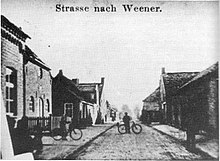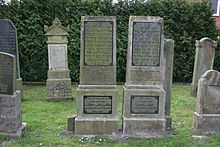Bunde Jewish Community
The Jewish community in Bunde existed for a period of around 150 years from its beginnings in the 18th century to its end on July 19, 1942.
History of the Jewish community in Bunde
The earliest mention of a Jew residing in Bunde is dated to 1670. At that time, the Jews of Bunde, Jemgum and Weener received permission from Countess Christine Charlotte to set up a cemetery in Smarlingen . In Bunde, the butcher Simon Isaacs is named, who was born in Emden as a child of Portuguese Jews. After his death in 1720 the family moved to the north and Emden. Nevertheless, in 1719 and 1752 two protective Jews are named in the place. Another mention of a Jew living in Bunde can be found in an appraisal register from 1786/87, in which the butcher Nathan Isaak appears.
Several families settled in the village during the 19th century. In 1824 there were 21 Jews in Bunde, with which the required number of ten male Jews over the age of 12 for a minyan was soon reached. The majority of them worked as butchers , second-hand dealers, or in both business areas, earning just as much money as was necessary for a living. This led to the fact that the butcher Salmon van Dyk was refused permission to settle in Bunde. This was justified with the reference to the fact that there were already enough butchers and traders in the place. Van Dyk must later have managed to settle in Bunde, because in 1853 it was he who turned to the authorities to prevent the butcher Meier Watermann from moving in. Van Dyk also wrote that the local three butchers barely earned the bare minimum for a living.
Around 1845 the Jewish community in Bunde then planned to build its own synagogue and school, for which a collection was requested from the Jemgum office. This forwarded the letter to the Landdrostei Aurich , but stated in a statement that the number of Jews living in Bunde was insufficient to maintain a synagogue in the opinion of the office. It referred to the experience in Jemgum. Due to the small size of the local community and the weak economic power of its members, the synagogue had to be auctioned shortly after its construction, was repurchased with outside help, but then fell into disrepair. The Landdrostei in Aurich followed the statement and in a letter dated April 30, 1845, rejected the collection and instructed the Jewish community in Bunde to better justify the need to build a synagogue.
This seems to have happened in the following years: Around 1846 the Jews of the village set up their own synagogue on Kreuzstrasse (today: Kirchring) and according to the school regulations of February 1, 1854, the Bunde synagogue community formed an independent school association with its own elementary school. In 1883 the community bought a piece of land to build a new school. Construction began immediately, so the building could be opened that same year. In addition to the school, it also contained the ritual women's bath and the apartment for the teacher. In 1896 a public Jewish school was planned. On December 7, 1896, the application was submitted with the designation Jewish religious school .
The Jews from Bunde had their dead buried initially in the Jewish cemetery in Smarlingen and then in Neuschanz . In 1874 the community in Neuschanz refused to use it any further. Thereupon the community applied to the Flecken Bunde to establish its own cemetery . The stain gave in to the application and on November 25th a piece of land was purchased for 250 Reichstaler, half of which was raised by the Jewish community. The rest was paid for with public funds.
Several Jews took part in the First World War as soldiers, none of whom fell. Georg and Adolf Gerson returned from the war with awards.
During the Weimar Republic, the parishioners made up around 3.5 percent (around 1924 there were around 70 Jews) of the total population of around 2,000. At that time the Jewish associations included the Chewra Kadischa charity and funeral association , the Israelite women's association and the Chewra bachurim association. In addition, there was probably a local branch of the Central Association of German Citizens of Jewish Faith since the early 1920s, but this is only documented from 1937. Economically, the already tense situation in most of the community deteriorated further. For example, at a meeting of the community leaders in Northwest Germany in 1930, the federal community leader reported that there was no money to pay a teacher and that the synagogue had been closed since the Feast of Tabernacles .
In January 1933, 52 Jews were still living in Bunde. More than half of them were 40 years or older. After the National Socialists came to power, 18 of them left their home community by the end of 1933. By the beginning of November 1938, a total of 38 Jews had moved. The majority of them emigrated to the nearby Netherlands. Ordinary church services and regular church life could no longer take place in this way. The community therefore sold its synagogue in July 1938 to the merchant Barfs and then dissolved. The synagogue is still standing today, but cannot be recognized as such due to several renovations.
Nevertheless, there were riots in Bunde in connection with the Reichspogromnacht . In Bunde, the local Sturmbannführer Annäus Winzenborg received a telephone instruction from Sturmbannführer Lahmeyer from Weener to allow the Jews living there to "catch up". The SA then drove all the Jews to the community hall and held them there, while other SA troops ransacked their homes in the meantime. By the next day most of the Jews had been released. Two of them were brought to Leer, from there with 54 Jewish men from the district of Leer and around 200 other Jewish East Frisians to Oldenburg, where they were rounded up in a barracks. Around 1,000 Jewish East Frisians, Oldenburgers and Bremen residents were then deported by train to the Sachsenhausen concentration camp north of Berlin.
The events were the last reason for the remaining Bunder Jews to emigrate. In September 1939 there was only one Jewish family of four left in Bunde. She left on March 21, 1940 in connection with the evacuation order for the East Frisian Jews. On July 19, 1942, the family was deported to Theresienstadt .
At least 23 of the 52 Jews who lived in Bunde in January 1933 perished in the Holocaust . However, there were probably significantly more. After the war, the Jewish Trust Corporation initially took over the 407 square meter cemetery from 1952 and handed it over to the regional association of Jewish communities in Lower Saxony in 1960 . The political municipality of Bunde has maintained the cemetery, on which around 30 graves have been preserved, since 1946. A gardener has been doing this since 1975. Repairs were carried out in 1956, 1970 and 1979.
Community development
In 1925 the Jewish community in Bunde made up 3.5% of the total population of the area. About 50 percent of the Bunder Jews came from the Netherlands.
|
Memorials
The Bunde Jewish cemetery from 1874 is located on Leege Weg.
Peter Könitz from Wymeer designed a memorial made of three bronze-colored stainless steel plates, which was erected in 2014 in the town center in front of the Sparkasse. The first plate bears the Bible verse from Isa 56,5b LUT and a reminder text as an inscription . The second is symbolically streaked with a crack. On the third plate, the names of 77 Bunder Jews can be read with the date, place and age of death.
See also
literature
- Herbert Reyer, Martin Tielke (ed.): Frisia Judaica. Contributions to the history of the Jews in East Frisia . Aurich 1988, ISBN 3-925365-40-0 .
- The end of the Jews in East Frisia. Catalog for the exhibition of the East Frisian landscape on the occasion of the 50th anniversary of Kristallnacht. Verlag Ostfriesische Landschaft, Aurich 1988, ISBN 3-925365-41-9 .
- Daniel Fraenkel: Bundles. In: Herbert Obenaus (Ed. In collaboration with David Bankier and Daniel Fraenkel): Historical manual of the Jewish communities in Lower Saxony and Bremen . Wallstein, Göttingen 2005, ISBN 3-89244-753-5 , pp. 380-384.
- Harm Wiemann u. a .: From bygone days: Chronicle of the Bunde Samtgemeinde . Ed. Samtgemeinde Bunde. Selbstverlag, Bunde 1983, pp. 97-102.
Individual evidence
- ↑ a b c Daniel Fraenkel: Bunde. In: Herbert Obenaus (Ed. In collaboration with David Bankier and Daniel Fraenkel): Historical manual of the Jewish communities in Lower Saxony and Bremen . Wallstein, Göttingen 2005, ISBN 3-89244-753-5 , pp. 380-384. P. 381.
- ↑ a b c Daniel Fraenkel: Bunde. In: Herbert Obenaus (Ed. In collaboration with David Bankier and Daniel Fraenkel): Historical manual of the Jewish communities in Lower Saxony and Bremen . Wallstein, Göttingen 2005, ISBN 3-89244-753-5 , pp. 380-384, p. 382.
- ↑ Harm Wiemann: On the history of the Jews in Bunde . In: Herbert Reyer, Martin Tielke (Ed.): Frisia Judaica. Contributions to the history of the Jews in East Frisia . Aurich 1988 (= treatises and lectures on the history of East Frisia. Volume 67). Pp. 163-170.
- ^ A b Alemannia Judaica: Bunde (Leer / Ostfriesland district, Lower Saxony) , viewed on July 16, 2013.
- ↑ a b c d e f g Daniel Fraenkel: Bunde. In: Herbert Obenaus (Ed. In collaboration with David Bankier and Daniel Fraenkel): Historical manual of the Jewish communities in Lower Saxony and Bremen . Wallstein, Göttingen 2005, ISBN 3-89244-753-5 , pp. 380-384. P. 383.
- ^ Bunde Jewish cemetery. In: Alemannia Judaica .
Coordinates: 53 ° 11 ′ 0 ″ N , 7 ° 16 ′ 0 ″ E



